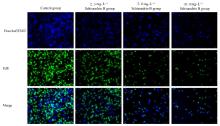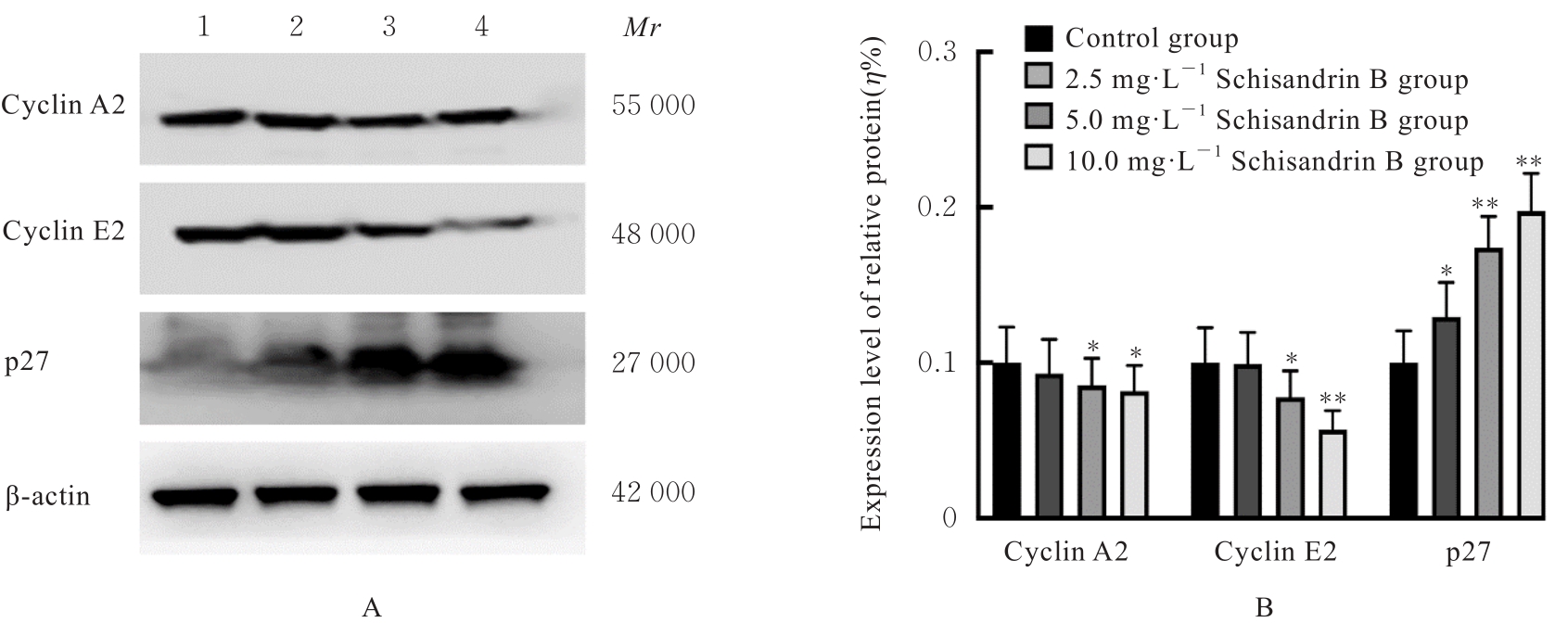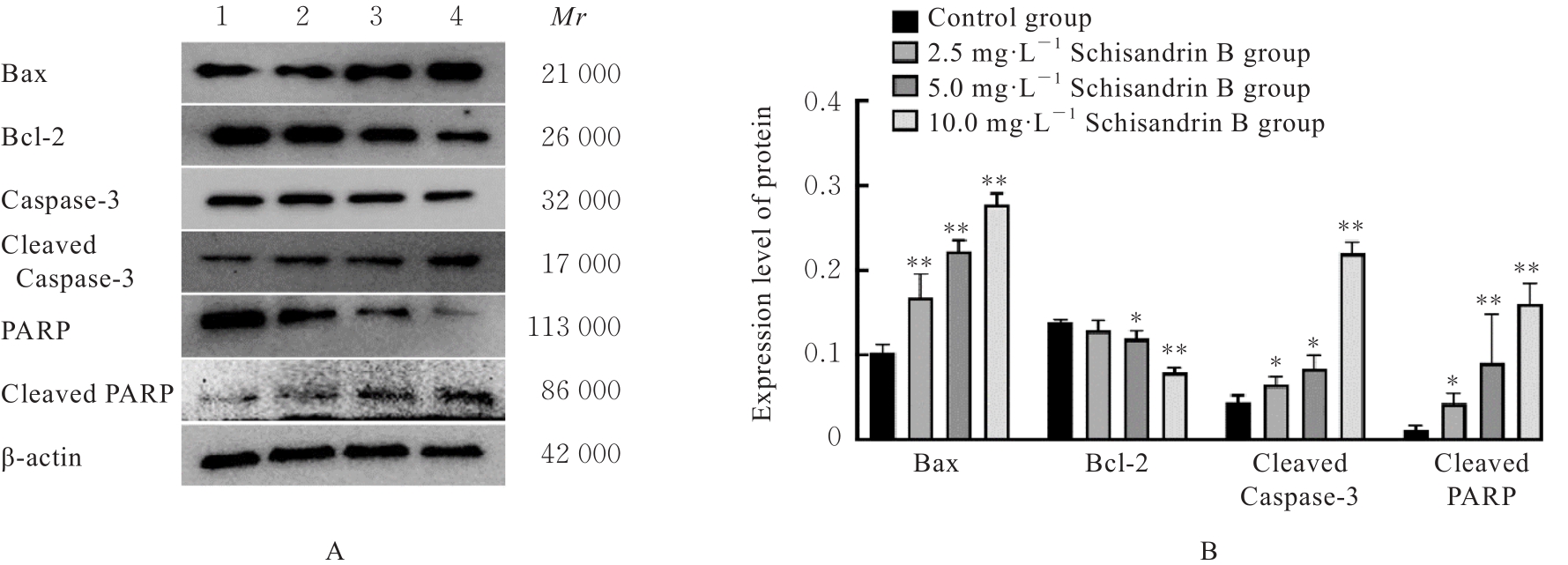吉林大学学报(医学版) ›› 2024, Vol. 50 ›› Issue (3): 638-646.doi: 10.13481/j.1671-587X.20240307
• 基础研究 • 上一篇
五味子乙素对胰腺癌Pan02细胞增殖的抑制作用及其机制
傅家财1,2,秦玲莎2,杨露2,宋美慧2,张仙映2,刘晓翠2,李凤金2( ),齐玲2(
),齐玲2( )
)
- 1.大理大学药学院,云南 大理 671000
2.广东医科大学附属清远医院 广东省清远市人民医院,广东 清远 511500
Inhibitory effect of Schisandrin B on proliferation of pancreatic cancer Pan02 cells and its mechanism
Jiacai FU1,2,Lingsha QING2,Lu YANG2,Meihui SONG2,Xianying ZHANG2,Xiaocui LIU2,Fengjin LI2( ),Ling QI2(
),Ling QI2( )
)
- 1.School of Pharmcy,Dali University,Dali 671000,China
2.Affiliated Qingyuan Hospital,Guangzhou Medical University,People’s Hospital,Qingyuan City,Guangdong Province,Qingyuan 511500,China
摘要:
目的 探讨五味子乙素对胰腺癌 Pan02 细胞增殖的抑制作用, 并阐明其作用机制。 方法 采用CCK-8法检测不同浓度(0、0.78、1.56、3.12、6.25、12.50和25.00 mg·L-1 )五味子乙素作用下Pan02细胞增殖率,以选择五味子乙素作用的最适浓度和最佳作用时间。小鼠胰腺癌 Pan02 细胞分为对照组(0 mg·L-1 五味子乙素)、2.5 mg·L-1 五味子乙素组、5.0 mg·L-1五味子乙素组和10.0 mg·L-1 五味子乙素组。光学显微镜观察各组Pan02细胞形态表现,5-乙基-2'-脱氧尿嘧啶核苷(EdU)染色法检测各组Pan02细胞中EdU阳性细胞率,流式细胞术检测各组不同细胞周期Pan02细胞百分率和细胞凋亡率,Western blotting法检测各组Pan02细胞周期和凋亡相关蛋白表达水平。 结果 CCK-8法,五味子乙素作用Pan02细胞48和72 h后,与0 mg·L-1 五味子乙素比较,其他浓度五味子乙素作用下Pan02细胞增殖率明显降低(P<0.01),72 h时细胞抑制作用最明显。选择0、2.5、5.0和10.0 mg·L-1五味子乙素作用Pan02细胞,作用时间为72 h。对照组Pan02细胞呈长梭形,状态良好,紧密且贴壁生长,细胞器和细胞质正常;2.5和5.0 mg·L-1五味子乙素组Pan02细胞体积减小,细胞之间黏连消失,细胞膜虽完整但通透性增强,细胞质皱缩,细胞内部产生空泡结构,部分呈碎片状漂浮于溶液表面;10.0 mg·L-1五味子乙素组Pan02细胞有明显凋亡小体生成,呈现凋亡状态。EdU染色法,与对照组比较,2.5、5.0和10.0 mg·L-1 五味子乙素组 Pan02 细胞中 EdU 阳性细胞率均明显降低(P<0.01)。流式细胞术,与对照组比较,2.5、5.0和10.0 mg·L-1五味子乙素组Pan02细胞S期细胞百分率明显升高(P<0.01),G2/M期细胞百分率明显降低(P<0.01),5.0和10.0 mg·L-1五味子乙素组G0/G1期细胞百分率明显降低(P<0.01);与对照组比较,2.5、5.0和10.0 mg·L-1五味子乙素组Pan02细胞凋亡率明显升高(P<0.01)。Western blotting法,与对照组比较,2.5 mg·L-1五味子乙素组Pan02细胞中p27、B细胞淋巴瘤2(Bcl-2)相关X蛋白(Bax)、裂解的半胱氨酸天冬氨酸蛋白酶3(cleaved Caspase-3)和裂解的多聚二磷酸腺苷(ADP)核糖聚合酶(cleaved PARP)蛋白表达水平明显升高(P<0.05或P<0.01);5.0和10.0 mg·L-1五味子乙素组Pan02细胞中细胞周期蛋白(Cyclin) A2、Cyclin E2 和 Bcl-2 蛋白表达水平均明显降低(P<0.05或P<0.01), p27、 Bax、 cleaved Caspase-3 和cleaved PARP 蛋白表达水平均明显升高(P<0.01)。 结论 五味子乙素具有抑制胰腺癌 Pan02 细胞增殖的作用,其作用机制可能与激活半胱氨酸天冬氨酸蛋白酶3(Caspase-3)通路诱导细胞凋亡和激活p27蛋白并诱导细胞周期S期阻滞有关。
中图分类号:
- R735.9












